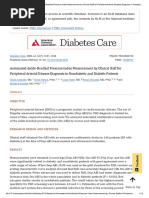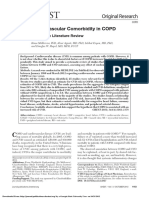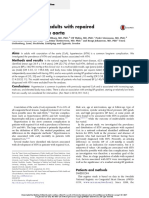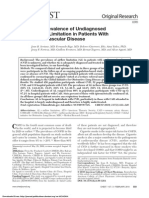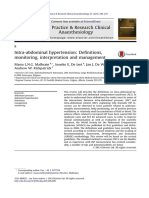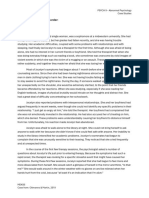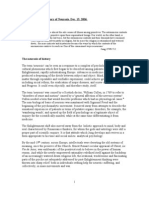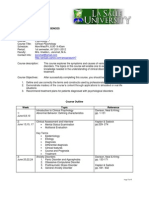Diagnosis2 (1) 1 PDF
Diagnosis2 (1) 1 PDF
Uploaded by
Robin WilliamsCopyright:
Available Formats
Diagnosis2 (1) 1 PDF
Diagnosis2 (1) 1 PDF
Uploaded by
Robin WilliamsOriginal Title
Copyright
Available Formats
Share this document
Did you find this document useful?
Is this content inappropriate?
Copyright:
Available Formats
Diagnosis2 (1) 1 PDF
Diagnosis2 (1) 1 PDF
Uploaded by
Robin WilliamsCopyright:
Available Formats
Eur J Vasc Endovasc Surg 29, 443451 (2005)
doi:10.1016/j.ejvs.2005.01.015, available online at http://www.sciencedirect.com on
REVIEW
The Validity, Reliability, Reproducibility and Extended Utility
of Ankle to Brachial Pressure Index in Current Vascular
Surgical Practice
M.F. Caruana, A.W. Bradbury and D.J. Adam*
University Department of Vascular Surgery, Birmingham Heartlands Hospital, Birmingham, UK
Background. Despite the increasing sophistication of vascular surgical practice, more than three decades after its
introduction to clinical practice, the ankle to brachial pressure index (ABPI) remains the cornerstone of non-invasive
assessment of the patient with symptomatic peripheral arterial disease (PAD).
Aim. To summarise what is known about ABPI and critically appraise its validity, reliability, reproducibility and extended
utility.
Methods. A MEDLINE (19662004) and Cochrane library search for articles relating to measurement of ABPI was
undertaken; see text for further details.
Results. There is considerable disagreement as to how ABPI should be measured. Furthermore, various factors, including
the type of equipment used, and the experience of the operator, can result in significant inter- and intra-observer error. As
such, care must be taken when interpreting data in the literature. ABPI is valuable in the assessment of patients with
atypical symptoms, venous leg ulcers and after vascular and endovascular interventions. However, absolute pressures are
probably more valuable in patients with critical limb ischaemia. ABPI is also useful in subjects with asymptomatic PAD
where it correlates well with, and may be used in screening studies to quantify, cardiovascular risk.
Conclusions. While its apparent simplicity can beguile the unwary, ABPI will continue to have a key role in the assessment
of symptomatic PAD. ABPI is also likely to have extended utility in health screening and institution of best medical therapy
in asymptomatic subjects.
Keywords: Ankle brachial pressure index; Peripheral arterial disease.
Introduction
Despite the increasing sophistication of vascular
surgical practice, more than three decades after its
introduction into clinical practice, the ankle to brachial
pressure index (ABI or ABPI) remains the cornerstone
of non-invasive assessment of the patient with
symptomatic peripheral arterial disease (PAD). While
Travis Winsor was the first to report in 1950 that the
ankle pressure is usually decreased if the arteries in
the lower limb are obstructed, Yao from St Marys
Hospital in London was the first to report in 1970 that
the severity of disease correlated to the drop in the
* Corresponding author. Mr D.J. Adam, Research Institute, Birmingham Heartlands Hospital, Lincoln House, Bordesley Green East,
Birmingham B9 5SS, UK.
E-mail address: donald.adam@heartsol.wmids.nhs.uk
10785884/000443 + 09 $35.00/0
ABPI.1 More recently, it has been developed as an
epidemiological tool for defining the natural history of
PAD. Furthermore, ABPI is likely to play a key role in
screening for individuals with asymptomatic PAD
who are at high cardiovascular risk and would benefit
from lifestyle advice and best medical therapy
(BMT).2,3 The purpose of this review is to critically
appraise the validity, reliability, reproducibility and
extended utility of the ABPI in clinical practice, and as
a research tool, in primary and secondary care.
Methods
A MEDLINE (19662004) and Cochrane library search
looking for articles relating to ABPI was performed.
The terms ankle pressure, ABI, ABPI, ankle arm index
q 2005 Elsevier Ltd. All rights reserved.
M. F. Caruana et al.
444
(AAI), toe pressures, cuff width, claudication and
angioplasty were amongst those included. These were
linked with terms such as cardiovascular disease,
diabetes and PAD. Further articles were identified by
following MEDLINE links, by cross-referencing from
the reference lists of major articles and by following
citations for these studies. The studies were then
graded with highest priority given according to the
level of evidence.
Results
ABPI methodology
Several methods for measuring ABPI have been
described.4 As well as producing different results in
individual patients, these different methodologies are
open to different forms of bias and will, therefore, be
associated with different levels of reproducibility
depending on the clinical circumstances. The higher
of the two pressures in the dorsalis pedis (DP) or the
posterior tibial (PT) arteries (or the peroneal artery if
no audible signal is forthcoming from these two
vessels) is conventionally taken as the ABPI numerator
and the higher of the two brachial pressures as the
denominator. In the absence of significant stenosis or
occlusion in these vessels the two values are usually
within 10 mmHg of each other5 even in the presence of
more proximal disease. Other workers have suggested
that averaging the DP and PT pressures correlates
more closely with limb function.6 Sometimes brachial
blood pressures are averaged and/or the brachial
pressure is only measured in one arm; usually the
right.7,8 It is worth noting that a pressure difference
between the right and left brachial arteries of at least
20 mmHg is present in 3.5% of the normal healthy
population8,9 and over 20% of patients with PAD.10 As
such, the pressure should be measured in both arms.
Although the higher of the two pressures will most
closely reflect central aortic pressure, it is possible for
patients with PAD to have bilateral subclavian-axillary
artery occlusive disease although the precise incidence
of this situation is difficult to determine. In these
circumstances, both brachial pressures will be artificially low and the ABPI artificially elevated.
Another potential source of variability, particularly
in longitudinal studies, is the non-linear relationship
between the central and ankle systolic pressures and
between central pressure and ABPI.10 In other words,
for the same degree of lower limb disease, ABPI will be
relatively lower in the presence of hypertension.1113
Furthermore, as hypertension is treated the ABPI will
Eur J Vasc Endovasc Surg Vol 29, May 2005
appear to improve. Finally, given the phenomenon of
white coat hypertension, it is likely that the ABPI
measured by a vascular surgeon in hospital will
appear lower that it would when measured by a
nurse in the patients own home. It is wise, therefore,
to record the absolute brachial and ankle pressures as
well as ABPI.
The method used to measure the brachial arterial
pressure also significantly affects the ABP1.14 As
mercury sphygmomanometers are gradually phased
out of clinical practice due to safety concerns,
automated devices using the oscillometric principle
(e.g. Dinamap) are becoming increasingly popular.15
Some studies suggest that the brachial and ankle
pressures can be accurately obtained using these
devices, and values closely resemble those obtained
using a pneumatic cuff and Doppler probe.16,17 This
fact, however, is not universally accepted. Indeed, in
one blinded study there was no correlation between
values obtained from all four limbs using the standard
Doppler technique and those obtained by an automated oscillometric device.18,19
The technique used to measure the brachial systolic
pressure can also influence the value of the ABPI.18,20
Use of oscillometric devices tends to overestimate the
systolic blood pressure when compared to using a
standard sphygmomanometer and this discrepancy is
more pronounced in subjects with stiff arteries.21 This
methodological variability is not limited to ABPI. Toe
pressures and cutaneous oxygen tension measurements are also significantly affected, particularly when
taken from the second toe rather than the hallux.22
The importance of blood pressure cuff position
It is worth re-emphasising that the ankle pressure is
actually the pressure under the cuff where it is
positioned on the calf and not where the Doppler
probe is positioned at the ankle. In patients with crural
disease the recorded ABPI may, therefore, vary
significantly depending on whether the cuff is placed
proximally over the bulk of the calf muscles, as may be
the case in a patient with a circumferential ulcer, or
distally, just proximal to the malleoli.23 This may lead
to inappropriate clinical decision making; for example,
regarding the use of compression in patients with
mixed arterial and venous ulcers. It is also worth
pointing out that as the ABPI is based upon the highest
of the three ankle pressures it puts the best light on
the perfusion of the foot. For example, a patient with
occlusion of PT and peroneal arteries but a relatively
normal anterior tibial artery may appear to have an
adequate ABPI and yet have little or no perfusion of
Ankle to Brachial Pressure Index
the posterior part of the foot and heel. Specifically,
patients with diabetes often have segmental crural and
pedal arterial disease resulting in very different levels
of perfusion in different parts of the foot. Furthermore,
ABPI may be falsely elevated because the arterial
disease is distal to the cuff and even the Doppler
probe.
The importance of blood pressure cuff size
Cuff size has an important effect on the indirect
measurement of blood pressure. Specifically, larger
cuffs should be used in the obese so as to avoid overestimating systolic brachial blood pressure and thus
under-estimating ABPI.24 Provided that the cuff is
placed as distally as possible on the calf, this may be
less of an issue in the measurement of ankle pressures
as even the morbidly obese tend not to have fat
ankles.25 However, it is highly relevant in patients
with oedema (lymphoedema and venous oedema) and
in children.26 Most clinicians tend to opt for a cuff that
is as wide as two-thirds to three-quarters of the upper
arm length and this has been shown to significantly
under-estimate both the systolic and diastolic blood
pressure when compared to measurements obtained
directly via a radial artery transducer. Early work in
this field by Geddes et al. has shown that using a cuff
with a bladder width of 40% of the upper arm
circumference gives a more accurate estimate of the
systolic blood pressure.24 In neonates and infants the
ABPI is physiologically lower than in older children
and adult values are reached during the second year of
life.27 The above facts must be kept in mind both when
assessing young infants for instance following iatrogenic catheterisation injuries and when such patients
are followed up into later childhood.
Reproducibility of ABPI
The significance of ABPI reproducibility, or lack of it,
depends upon the context in which it is being used.
For example, as inter-observer variability is considerably less than the biological variability between
normal subjects and those affected by different stages
of disease, lack of reproducibility is generally not an
issue in epidemiological studies.28 This is not necessarily the case when ABPI is being used to define the
natural history of PAD or treatment outcomes in
individual patients being studied longitudinally. In
these circumstances, multiple measurements both at
baseline and during follow-up are recommended.29,30
For example, one hospital-based study found that 30%
of the ABPIs performed by junior doctors were
445
incorrect when compared to the values obtained by
vascular technicians; this figure improved to 15% after
formal training.31 This may partially relate to the fact
that within the vascular laboratory, the brachial
systolic pressure is more likely to be estimated using
a Doppler probe, whereas house officers tend to rely
on the Korotkoff method20 which tends to yield lower
values for the systolic pressure. Significant variability
between measurements depending upon degree of
experience has also been shown in other more recent
studies.29,32 The impact of both inter-observer and
intra-observer error on reproducibility has been
quantified in a Dutch general practice based study.33
When the ABPI was used to follow up patients with
PAD, the difference between two sequential ratios had
to be at least 19% in order to exclude an intra-observer
error. This reaffirms the generally accepted notion that
the ABPI must change by at least 0.15 before this can
be considered to be clinically significant.30
Implications of variability and methodology for practice
Taken together the various factors influencing the
measurement and reproducibility of ABPI can have a
profound effect upon the data being collected and
recorded for clinical practice, as well as scientific
reporting. While there may not be one best way of
measuring ABPI, it is important that individual
clinical units and research teams:
& Formally train their observers (whether they be
doctors, nurses, or technologists) using a standardised methodology
& Record their results in a standardized manner for
day to day clinical practice
& State their preferred method explicitly when
reporting in the literature
& Audit their results34
to ensure that the apparent simplicity of the ABPI
does not beguile them in to making inappropriate
clinical decisions, drawing erroneous conclusions with
regard to the outcome from vascular interventions, or
publishing spurious data.
Association between ABPI and clinical stage of PAD
In the aggregate, ABPI correlates well with the
angiographic severity of lower limb arterial occlusive
disease5,35 and the resulting functional impairment
both objectively and as perceived by the patient.36 In
healthy individuals the ABPI is usually 1.01.2 in the
supine position.36,37 The peak systolic ankle pressure
Eur J Vasc Endovasc Surg Vol 29, May 2005
M. F. Caruana et al.
446
tends to be higher at the ankle than at the arm because
of pressure augmentation by the muscular peripheral
arteries as well as the summation of reflected pressure
waves.38 As stressed below, ankle pressures must be
measured with the patient supine, not least because of
the veno-arteriolar reflex. In healthy individuals,
standing up activates this reflex which leads to
arteriolar vasoconstriction and an overall restriction
in arterial flow.39 This mechanism is significantly
impaired in patients with SCLI and CLI,40 chronic
venous disease and in diabetics with autonomic
neuropathy. Patients with intermittent claudication
(IC) usually have an ABPI of 0.50.8 while those with
sub-critical (SCLI)41 and critical limb ischaemia (CLI)
usually have ABPI of !0.5 and !0.3, respectively. The
association between disease severity and the ABPI
applies not only to hospital patients, but also to
community-based studies.1 However, there can be
considerable overlap in ABPI between these major
clinical groups and, as with many clinical measurements, it is the trend over time, rather than the
absolute index, that is most clinically important on an
individual patient basis.
A significant number of patients presenting to
vascular clinics can be difficult to assess2,42,43 either
because they have:
& PAD with atypical symptoms or
& other pathology (e.g. spinal stenosis) to explain
their leg symptoms in the presence of asymptomatic PAD
ABPI can be particularly helpful in such circumstances by allowing the clinician to correlate the
patients subjective symptoms with an objective
measure of arterial disease severity.
Value of ABPI in critical limb ischaemia
In patients with potentially limb-threatening ischaemia there appears to be a better relationship between
symptoms, limb viability, treatment opportunities and
outcome and absolute pressures than there is with
ABPI.4446 A review of the results of 20 publications
reporting 6118 patients,41 demonstrated that patients
with SCLI (defined as rest pain and/or an absolute
ankle pressure of more than 40 mmHg) were at
significantly lower risk of limb loss than patients
with CLI (tissue loss or an absolute ankle pressure of
less than 40 mmHg). However, while easy to recognise
clinically, CLI has proved surprisingly difficult to
define for purposes of scientific reporting. The
European Consensus Document definition of CLI,
Eur J Vasc Endovasc Surg Vol 29, May 2005
which remains controversial and is by no means
strictly observed in the literature,47 includes an
absolute ankle pressure !50 mmHg or toe pressure
less than 30 mmHg.48 The latter is also included in the
Trans-Atlantic Inter-Society Consensus recommendations and is recommended for patients with
calcified crural arteries.44 However, toe pressures
have a low positive and a high negative predictive
value when used to detect CLI and are, therefore, more
useful in the exclusion of CLI than its confirmation.44
See section on the pole test below.
ABPI and chronic venous ulceration
In patients with chronic venous ulceration (CVU), it is
currently recommended that the ABPI should be O0.8
if compression bandaging is to be applied safely in the
community.49 This is a major issue with district and
practice nurses increasingly referring patients with
CVU to vascular clinics for measurement of ankle
pressures and ABPI; or for confirmation of ankle
pressures and ABPI measured in primary care. ABPI
in patients with CVU must be interpreted with caution
for a number of reasons:
In patients with low central systolic pressure, or in
whom this is underestimated because of PAD in the
upper extremity, the ABPI under-represents the
degree of arterial disease in the lower extremity.50
Absolute systolic ankle pressures may be more
meaningful in this situation.
The ABPI is representative of the highest systolic
pressure measured at the ankle. In patients where
individual calf vessels are heavily diseased or
occluded while a single tibial vessel is relatively
preserved, the ABPI would fail to indicate the fact
that part of the calf may be significantly underperfused and, therefore, more susceptible to pressure damage. A difference of O10 mmHg5 between
systolic pressure readings taken from different
pedal vessels should alert the clinician to this
possibility.
The ABPI may be inaccurate if the cuff is placed
proximally over the bulk of the calf muscles, as may
be the case in a patient with a circumferential
ulcer.23 This may lead to inappropriate use of
compression therapy in patients with mixed
arterio-venous ulcers.
Non-compressibility of vessels
Many patients with PAD, particularly those with
diabetes and end-stage renal failure, have calcified
Ankle to Brachial Pressure Index
and incompressible crural vessels leading to spuriously elevated ABPI.51 The degree to which the ABPI
can be raised is variable and difficult to quantify, once
again emphasising the need to interpret the index in
the light of clinical findings and other investigations. If
there is doubt about the validity of the ABPI then two
alternatives are to use toe pressures to calculate the
TBPI52,53 or to utilize the pole test.54,55 In the latter,
with the patient supine, the foot is elevated against a
calibrated pole. The height above the heart at which
the ankle or toe Doppler signal disappears approximates the perfusion pressure at the site of the probe in
centimetres of water from which a value in mmHg can
be derived (1.36 cm of water equals 1 mmHg). In
practice, if the Doppler signals are still present at the
ankle with the hip elevated to 908 then this effectively
excludes CLI (i.e. the perfusion pressure exceeds
50 mmHg) and is a useful semi-quantitative screening
test.
Effect of exercise on the ABPI
Exercise results in local vasodilation and this rapidly
overcomes the vasoconstrictive response to postural
changes. In normal individuals this results in a
significant increase in the total blood flow and the
blood pressure is maintained.37 This increased flow
would amplify the resistance across both a significant
stenosis in an arterial trunk feeding the intramuscular
arterioles and across a collateral system bypassing an
occluded artery. Consequently, the pressure in a
vascular bed distal to such a lesion would fall and
remains low while exercise continues and until the
local vasodilator mediators are washed out of the limb.
This explains how the presence of mild to moderate
PAD causes the ABPI to drop after exercise and why
the length of the recovery period is proportional to the
severity of the disease. To obtain a true resting ABPI, it
is necessary for the patient to rest supine for 1020 min
after walking to the clinic.
ABPI and the outcome of vascular surgery
It is widely accepted that successful aorto-iliac and
infra-inguinal arterial reconstruction is accompanied
by a significant increase in ABPI.37 The magnitude as
well as time scale over which this increase occurs
depends very much upon the extent of the underlying
disease as well as the type and extent of intervention.35
For instance, following an aorto-bifemoral bypass for
isolated iliac vessel disease, one would expect a near
instantaneous rise in the ABPI to normal.56 Following
a femoro-popliteal bypass the rise in ABPI may take
447
up to 4 h to complete, and after profundaplasty this
may take over 24 h. Indeed, there is some evidence
that ABPI may continue to rise for several months
following successful surgery.35
Serial ABPI measurement alone has been shown to
have a very low positive predictive value for vein graft
occlusion following infra-inguinal bypass.57 It is also
insensitive in predicting impending graft failure. In
one study only 38% of limbs demonstrated an ABPI
drop of 0.15 or more on graft occlusion.58 Long-term
outcome for aorto-iliac and infra-inguinal bypass
depends primarily upon progression of PAD, and the
ABPI appears to be relatively insensitive in detecting
disease progression when compared to angiography
or duplex scanning.59 Despite these points, a significant drop in the ABPI (O0.15) following surgery
should, if clinically indicated, prompt further graft
assessment. This is supported by data from the recent
vein graft surveillance trial (VGST). This European
Multicentre randomised control trial60,61 has shown
that routine duplex graft surveillance is unjustified in
terms of cost and clinical outcome when compared to
standard clinical follow-up and ABPI measurement
followed by selective duplex scanning. The importance of ensuring standardisation and applying local
quality control to ABPI measurement cannot be
overemphasized in this respect.
ABPI and the outcome of endovascular intervention
ABPI appears to increase more slowly after successful
angioplasty and may continue to increase for at least a
month after the procedure.62,63 This has been shown to
correlate with changes in flow rate62 and is independent of any calf swelling related to reperfusion. This
suggests that relying on a single measurement of ABPI
taken soon after endovascular intervention (or surgical
bypass for that matter) may underestimate the success
of the procedure as well as the deterioration associated
with post-procedural failure or disease progression.63
The ABPI also appears to be relatively insensitive as a
tool for longitudinal studies of patients following
angioplasty. In one prospective study of patients
following successful superficial femoral artery angioplasty, deterioration in the ABPI by 0.15 was highly
specific for reocclusion or stenosis but pressure
measurements showed poor sensitivity in detecting
re-stenosis or occlusion.64,65
ABPI and the outcome of medical treatment
While intermittent claudication can often be attributed
to specific abnormalities in the arterial tree, the
Eur J Vasc Endovasc Surg Vol 29, May 2005
M. F. Caruana et al.
448
pathophysiology is more complex than simply altered
large vessel haemodynamics.66 Various local metabolic
effects distal to a stenosis or occlusion may all play a
role in the progression of the disease independently
from changes in the ABPI: changes in the production
of local vasodilating agents such as adenosine, and
systemic haematologic effects such as impaired fibrinolysis and increased blood viscosity may contribute.
Conversely, medical treatment such as cilostazol and
pentoxifylline may improve symptoms without
necessarily affecting the ABPI. Cilostazol is a selective
phosphodiesterase III inhibitor which has beneficial
effects on platelet function and cholesterol metabolism, causes vasodilation and inhibits smooth muscle
proliferation.67 Cilostazol has been shown to increase
resting ABPI and improve the post-exercise recovery
time68 but this may not fully represent its therapeutic
effect. For this reason the large trials of cilostazol used
initial claudication distance and absolute claudication
distance as their primary endpoints.69,70
Current evidence would suggest that supervised
exercise programmes for intermittent claudication
are both safe and effective.71 Exercise is postulated
to increase walking distance by enhancing the
oxidative capacity of skeletal muscle cells, increasing the reliance on non-ischaemic muscles and
promoting the development of collateral vessels.66
These effects would be under-represented by
changes in the ABPI and, therefore, endpoints
such as changes in quality of life scores and
treadmill walking distances are of more relevance
for instance when comparing different approaches
to exercise therapy.72
It is clear, therefore, that the ABPI, being a measure
of changes in the pressure gradient within the axial
arteries, cannot be solely and directly used as a marker
for proof of concept or mechanism for new treatment
modalities that act at the molecular level. This point
may become even more relevant in future as newer
treatment modalities emerge aimed at promoting
angiogenesis.
ABPI and asymptomatic PAD
The relationship between lower limb symptoms,
ABPI and cardiovascular risk is an important one.
As described above, a normal ABPI at rest does not
exclude the presence of haemodynamically significant lower limb atherosclerosis and if there is
strong suspicion that the patients symptoms are
vascular in aetiology, then ABPI should be
repeated after exercise testing. Similarly, the
absence of symptoms does not exclude the
Eur J Vasc Endovasc Surg Vol 29, May 2005
presence of significant lower limb PAD. A lack of
lower limb symptoms in the presence of a low
resting or post-exercise ABPI (typically claudication) may simply be due to the patients choice not
to walk, or due to other exercise limiting pathology
(e.g. osteoarthritis, angina, breathlessness) or diabetic neuropathy.
It is now quite clear from several large longitudinal
studies (Table 1) that a low ABPI, usually taken as !
0.8 or !0.9, is associated with a marked increase in
cardiovascular events, recurrent events and mortality,
whether lower limb symptoms are present or not.2,8,7382
Furthermore, the Edinburgh Artery Study has shown
that even a near-normal ABPI (0.911.0) is associated
with reduced 5 year survival.8
The data shown in Table 1 suggests that ABPI can be
used in primary care to screen for early asymptomatic
and symptomatic PAD. The institution of BMT in such
individuals83,84 would lead to a significant reduction
in disease progression, cardiovascular events and
mortality, and health care spending on more advanced
vascular disease in secondary care. The results of
further ongoing studies (e.g. the POPADAD study) in
this respect where the ABPI is a primary endpoint are
eagerly awaited.85 ABPI could also be used selectively
to identify those individuals engaged in certain critical
occupations (e.g. heavy goods vehicle drivers, airline
pilots) who are at particularly high risk of sudden and
incapacitating cardiovascular events such as myocardial infarction and stroke.
Discussion
Although it is used day-in day-out across the
world in primary and secondary care, it is clear
that there is more to the ABPI than first meets the
eye and that its apparent simplicity may beguile
the unwary. In particular, care needs to be taken
with methodology and training, reproducibility,
interpretation, clinical recording and scientific
reporting. However, when used properly, the
ABPI remains an invaluable tool in assessment of
vascular patients, especially those with atypical
presentation, and in determining the success or
otherwise of surgical, endovascular and medical
interventions. But perhaps the most exciting area is
the extended utility of the ABPI as a basis for
community and occupational health screening and
the opportunities that would herald for the early
detection and evidence-based, clinically and costeffective, treatment of vascular disease.
Ankle to Brachial Pressure Index
449
Table 1. Studies examining the relationship between ABPI and cardiovascular outcome
NZ
Study
McKenna M et al.74
Vogt MT et al.75
Fishbane S et al.76
744
1930
Study method
Follow-up
Major findings
Patients investigated noninvasively for PAD
Patients aged O50 years
referred for arterial
assessment
Retrospective
Prospective
cohort
13 years
1 year
RR for death 2.36 if ABPI !0.85. RR for
MI 4.49 if ABPI !0.4
ABPI !0.9, strong predictor for all-cause
mortality (RR for men Z1.8, RR for women
Z1.5) and CHD mortality (RR for men Z2.0,
RR for women Z2.1)
ABPI !0.9, RR for cardiovascular mortality
Z7.5
ABPI !0.9, RR for non-fatal MI Z1.38, RR
for CVA Z1.98, RR for cardiovascular
mortality Z1.85 and RR for all-cause
mortality Z1.58
ABPI!0.9, RR for all-cause mortality Z1.62;
incidence of cardiovascular events increase
with each ABPI decrement of 0.1
Overall inverse trend between ABPI and
incidence of CVA, RR for CVA Z1.93 if ABPI
!0.8
RR for mortality (adjusted) increases by 1.17
per 0.2 decrement in ABPI
RR for all-cause mortality Z2.1 if ABPI 0.51
0.8, and 3.4 if ABPI ! 0.5
Significant increase in risk of CVA or TIA if
ABPI !0.9
Leng GC et al.
1592
Age stratified population
sample aged 5574 years
Prospective
observational
Prospective
cohort
Newman AB et al.73
5888
Population sample aged
O65 years
Population
observational
10 years
Tsai AW et al.78
14839
Population sample aged
4564 years
Prospective
observational
7 years
Powell J et al.79
2305
Patients with abdominal
aortic aneurysm
Population sample aged
5089 years
Elderly healthy population:
mean age 80 years
Prospective
observational
Prospective
cohort
Prospective
observational
study
5.7 years
77
80
132
Cohort
Jonsson B et al.
353
Murabito JM et.al.81
674
Haemodialysis patients
5 years
10 years
4 years
RR, relative risk; CHD, coronary heart disease; MI, myocardial infarction; CVA, stroke; TIA, transient ischaemic attack.
References
1 Yao ST. Haemodynamic studies in peripheral arterial disease. Br
J Surg 1970;57:761766.
2 Hirsch AT, Criqui MH, Treat-Jacobson D et al. Peripheral
arterial disease detection, awareness, and treatment in primary
care (the partners study). JAMA 2001;286(11):13171323.
3 Burns P, Gough S, Bradbury AW. Management of peripheral
arterial disease in primary care. Br Med J 2003;326:584588.
4 Ouriel K, Zarins CK. Doppler ankle pressure: an evaluation
of three methods of expression. Arch Surg 1982;117(10):1297
1300.
5 Carter SA. Clinical measurement of systolic pressures in limbs
with arterial occlusive disease. JAMA 1969;207:1869.
6 Mcdermott MM, Criqui MH, Liu K. Lower ankle/brachial
index, as calculated by averaging the dorsalis pedis and posterior
tibial arterial pressures, and association with leg functioning in
peripheral arterial disease. J Vasc Surg 2000;32(6):11641171.
7 Aboyans V, Lacroix P, Lebourdon A, Preux PM, Ferrieres J,
Laskar M. The intra- and inter-observer variability of ankle-arm
blood pressure index according to its mode of calculation. J Clin
Epidemiol 2003;56(3):215220.
8 Smith FB, Lee AJ, Price JE, Van Wijk MCW, Fowkes FGR.
Changes in ankle brachial index in symptomatic and asymptomatic subjects in the general population. J Vasc Surg 2003;
38:13231330.
9 Lane D, Beevers M, Barnes N et al. Inter-arm differences in
blood pressure: when are they clinically significant? J.Hypertens
2002;20(6):10891095.
10 Frank SM, Norris EJ, Christopherson R, Beattie C. Rightand left-arm blood pressure discrepancies in vascular surgery
patients. Anaesthesiology 1991;75(3):457463.
11 Belcaro G, Nicolaides AN. Pressure index in hypotensive or
hypertensive patients. J Cardiovasc Surg 1989;30(4):614617.
12 Carser DG. Do we need to reappraise our method of interpreting the ankle brachial pressure index? J Wound Care 2001;
10(3):5962.
13 Hugue CJ, Safar ME, Aliefierakis MC et al. The ratio between
ankle and brachial systolic pressure in patients with sustained
14
15
16
17
18
19
20
21
22
23
24
uncomplicated essential hypertension. Clin Sci (Lond) 1988;
74(2):179182.
Jeelani NU, Braithwaite BD, Tomlin C, Macsweeney ST.
Variation of method for measurement of brachial artery pressure
significantly affects ankle-brachial pressure index values. Eur
J Vasc Endovasc Surg 2000;20(1):2528.
Pickering TG. Principles and techniques of blood pressure
measurement. Cardiol Clin 2002;20(2):207223.
Lee BY, Campbell JS, Berkowitz P. The correlation of ankle
oscillometric blood pressures and segmental pulse volumes to
Doppler systolic pressures in arterial occlusive disease. J Vasc
Surg 1996;23(1):116122.
Mundt KA, Chambless LE, Burnham CB, Heiss G. Measuring
ankle systolic blood pressure: validation of the Dinamap 1846 SX.
Angiology 1992;43(7):555566.
Jonsson B, Lindberg LG, Skau T, Thulesius O. Is oscillometric
ankle pressure reliable in leg vascular disease? Clin Physiol 2001;
21(2):155163.
Ramanathan A, Conaghan PJ, Jenkinson AD, Bishop CR.
Comparison of ankle-brachial pressure index measurements
using an automated oscillometric device with the standard
Doppler ultrasound technique. ANZ J Surg 2003;73(3):105108.
Jeelani NU, Braithwaite BD, Tomlin C, Macsweeney ST.
Variation of method for measurement of brachial artery pressure
significantly affects ankle-brachial pressure index values. Eur
J Vasc Endovasc Surg 2000;20(1):2528.
van Popele NM, Bos WJ, de Beer NA et al. Arterial stiffness as
underlying mechanism of disagreement between an oscillometric
blood pressure monitor and a sphygmomanometer. Hypertension
2000;36:484488.
de Graaf JC, Ubbink DT, Legemate DA, de Haan RJ, Jacobs MJ.
Interobserver and intraobserver reproducibility of peripheral
blood and oxygen pressure measurements in the assessment of
lower extremity arterial disease. J Vasc Surg 2001;33(5):10331040.
Anderson I. The effect of varying cuff position on recording
ankle systolic blood pressure. J Wound Care 2002;11(5):185189.
Geddes LA, Tivey R. The importance of cuff width in
measurement of blood pressure indirectly. Card Res Cen Bull
1976;14(3):6979.
Eur J Vasc Endovasc Surg Vol 29, May 2005
450
M. F. Caruana et al.
25 Pollak EW, Chavis P, Wolfman EF. The effect of postural
changes upon the ankle arterial perfusion pressure. Vasc Surg
1976;10(4):219222.
26 Clark JA, Leih-lai MW, Sarnaik A, Mattoo TK. Discrepancies
between direct and indirect blood pressure measurements using
various recommendations for arm cuff selection. Pediatrics 2002;
110(5):920923.
27 Katz S, Globerman A, Avitzour M, Dolfin T. The anklebrachial pressure index in normal neonates and infants is
significantly lower than in older children and adults. J Pediatr
Surg 1997;32(2):269271.
28 Fowkes FG, Housley E, Macintyre CC, Prescott RJ,
Ruckley CV. Variability of ankle and brachial systolic pressures
in the measurement of atherosclerotic peripheral arterial disease.
J Epid Community Health 1988;42(2):128133.
29 Kaiser V, Kester AD, Stoffers HE, Kitslaar PJ,
Knottnerus JA. The influence of experience on the reproducibility of the ankle-brachial systolic pressure ratio in peripheral
arterial occlusive disease. Eur J Vasc Endovasc Surg 1999;18(1):25
29.
30 Baker JD, Dix DE. Variability of Doppler ankle pressures with
arterial occlusive disease: an evaluation of ankle index and
brachial-ankle pressure gradient. Surgery 1981;89(1):134137.
31 Ray SA, Srodon PD, Taylor RS, Dormandy JA. Reliability of
ankle: brachial pressure index measurement by junior doctors. Br
J Surg 1994;81:188190.
32 Matzke S, Frankena M, Alback A, Railo M, Lepantalo M.
Ankle brachial index measurements in critical leg ischaemiainfluence of experience on reproducibility. Scand J Surg 2003;
92(2):144147.
33 Stoffers J, Kaiser V, Kester A, Schouten H, Knottererus A.
Peripheral arterial occlusive disease in general practice: the
reproducibility of the ankle-arm systolic pressure ratio. Scand
J Prim Health Care 1991;9(2):109114.
34 Fischer CM, Burnett A, Makeham V, Kidd J, Glasson M,
Harris JP. Variation in measurement of ankle-brachial pressure
index in routine clinical practice. J Vasc Surg 1996;24(5):871875.
35 Yao JST, Hobbs JT, Irvine WT. Ankle systolic pressure
measurements in arterial diseases affecting the lower extremities.
Br J Surg 1969;56:676.
36 Yao JST. Haemodynamic studies in peripheral arterial disease. Br
J Surg 1970;57:671.
37 Cutajar CL, Marston A, Newcombe JF. Value of cuff occlusion
pressures in assessment of peripheral vascular disease. Br Med J
1973;2:392395.
38 Strandness DE, Sumner DS. Hemodynamics for surgeons. New
York, Grune & Stratton, 1975, p. 21.
39 Sumner DS. In: Rutherford RB, ed. Vascular Surgery. 4th ed
Philadelphia: WB Saunders, 1995:1844.
40 Delis KT, Lennox AF, Nicolaides AN, Wolfe JH. Sympathetic
autoregulation in peripheral vascular disease. Br J Surg 2001;
88(4):523528.
41 Wolfe JH, Wyatt MG. Critical and subcritical ischaemia. Eur
J Vasc Endovasc Surg 1997;13(578):582.
42 Mcdermott MM, Greenland P, Liu K et al. Leg symptoms in
peripheral arterial disease: associated clinical characteristics and
functional impairment. JAMA 2001;286(13):15991606.
43 Mcdermott MM, Fried L, Simonsick E et al. Asymptomatic
peripheral arterial disease is independently associated with
impaired lower extremity functioning. Circulation 2000;101:1007
1012.
44 Kroger K, Stewen C, Santosa F, Rudofsy G. Toe pressure
measurements compared to ankle artery pressure measurements.
Angiology 2003;54(1):3944.
45 Brothers TE, Esteban R, Robison JG, Elliott BM. Symptoms
of chronic arterial insufficiency correlate with absolute ankle
pressures better than with the ankle: brachial index. Minerva
Cardioangiol 2000;48((45)):103109.
46 Ubbink DT, Tulevski II, Den Hartog D et al. The value of noninvasive techniques for the assessment of critical limb ischaemia.
Eur J Vasc Endovasc Surg 1997;13(3):296300.
Eur J Vasc Endovasc Surg Vol 29, May 2005
47 Bradbury AW. Angioplasty is the first line treatment for critical
limb ischaemia: against the motion. In: Greenhalgh RM, ed.
Vascular and endovascular controversies. BIBA Publishing,
2003:295307 [25th International Charing Cross Symposium].
48 Second European Consensus Documentation on Chronic Critical
Limb Ischaemia. Standard criteria for diagnosing critical limb
ischaemia. Eur J Vasc Surg 1992;6(Suppl A):14.
49 London NJM, Donnelly R. ABC of arterial and venous disease:
ulcerated lower limb. BMJ 2000;320:15891591.
50 Carser DG. Do we need to reappraise our method of interpreting the ankle brachial pressure index? J Wound Care 2001;
10(3):5962.
51 Vincent DG, Salles-Cunha SX, Bernhard VM, Towne JB.
Noninvasive assessment of toe systolic pressures with special
reference to diabetes mellitus. J Cardiovasc Surg 1983;24(1):2228.
52 Brooks B, Dean R, Patel S, Wu B, Molyneaux L, Yue DK. TBI or
not TBI: that is the question. Is it better to measure toe pressure
than ankle pressure in diabetic patients? Diabet Med 2001;
18(7):528532.
53 Smith FC, Shearman CP, Simms MH, Gwynn BR. Falsely
elevated ankle pressures in severe leg ischaemia: the pole test
an alternative approach. Eur J Vasc Endovasc Surg 1996;12(1):125
126.
54 Pahlsson HI, Wahlberg E, Olofsson P, Swedenborg J. The toe
pole test for evaluation of arterial insufficiency in diabetic
patients. Eur J Vasc Endovasc Surg 1999;18(2):133137.
55 Goss DE, Stevens M, Watkins PJ, Baskerville PA. Falsely raised
ankle/brachial pressure index: a method to determine tibial
artery compressibility. Eur J Vasc Surg 1991;5(1):2326.
56 Kozloff L, Collins GJ, Rich NM et al. Fallibility of postoperative Doppler ankle pressures in determining the adequacy
of proximal arterial revascularization. Am J Surg 1980;139:326
329.
57 Mattos MA, Bemmelen PS, Hodgson KJ et al. Does correction of
stenoses identified with colour duplex scanning improve infrainguinal graft patency? J Vasc Surg 1993;17:5466.
58 Idu MM, Blankenstin JD, Gier P et al. Impact of a color-flow
duplex surveillance program on infrainguinal graft patency: a
five year experience. J Vasc Surg 1993;17:4253.
59 Mclafferty RB, Moneta GL, Taylor LM, Porter JM. Ability of
ankle-brachial index to detect lower-extremity atherosclerotic
disease progression. Arch Surg 1997;132:836841.
60 Kirby PL, Brady AR, Thompson SG et al. The vein graft
surveillance trial: rationale, designs and methods. VGST participants. Eur J Vasc Endovasc Surg 1999;18(6):469474.
61 Davies AH, on behalf of the VGST participants. Duplex
surveillance of Femoro-distal bypass vein grafts is of no benefit.
VSSGBI yearbook 2003: 68. Shropshire, UK, tfm Publishing Ltd,
2003.
62 Allouche-Cometto L, Leger P, Rousseau H, Lefebvre D,
Bendayan P, Elfterion P et al. Comparative of blood flow to the
ankle-brachial index after iliac angioplasty. Int Angiol 1999;
18(2):154157.
63 Ray SA, Buckenham TM, Belli AM, Taylor RS, Dormandy JA.
The nature and importance of changes in toe- brachial pressure
indices following percutaneous transluminal angioplasty for leg
ischaemia. Eur J Vasc Endovasc Surg 1997;14(2):125133.
64 Decrinis M, Doder S, Stark G, Pilger E. A prospective
evaluation of sensitivity and specificity of the ankle/brachial
index in the follow-up of superficial femoral artery occlusions
treated by angioplasty. Clin Investig 1994;72(8):592597.
65 Dalsing MC, Cikrit DK, Laika SG et al. Femorodistal vein
grafts: the utility of graft surveillance criteria. J Vasc Surg 1995;
21(1):127134.
66 Tjon JA, Riemann LE. Treatment of intermittent claudication
with pentoxifylline and cilostazol. Am J Health-Syst Pharmacol
2001;58(6):485496.
67 Chapman TM, Goa KL. Cilostazol: a review of its use in
intermittent claudication. Am J Cardiovasc Drugs 2003;3(2):117
138.
Ankle to Brachial Pressure Index
68 Mohler III ER, Beebe HG, Salles-Cuhna S et al. Effects of
cilostazol on resting pressures and exercise-induced ischaemia in
patients with intermittent claudication. Vasc Med 2001;6(3):151
156.
69 Dawson DL, Cutler BS, Meissner MH, Strandness Jr DE.
Cilostazol has beneficial effects in treatment of intermittent
claudication: results from a multicenter, randomized, prospective, double-blind trial. Circulation 1998;98(678):686.
70 Money SR, Herd JA, Isaacsohn JL et al. Effect of cilostazol on
walking distances in patients with intermittent claudication
caused by peripheral vascular disease. J Vasc Surg 1998;27:267
274.
71 Shearman CP, Baxter S. Claudication should have supervised
exercise and medical treatment ahead of any intervention: for the
motion. In: Greenhalgh RM, ed. Vascular and endovascular
controversies. BIBA Publishing, 2003:249255 [25th International
Charing Cross Symposium].
72 Cheetham DR, Burgess L, Ellis M et al. Does supervised
exercise offer adjuvant benefit over exercise advice alone for the
treatment of intermittent claudication? A randomised trial. Eur
J Vasc Endovasc Surg 2004;27(1):1723.
73 Newman AB, Shemanski L, Manolio TA et al. Ankle-arm index
as a predictor of cardiovascular disease and mortality in the
cardiovascular health study. Arterioscler Thromb Vasc Biol 1999;
19:538545.
74 Mckenna M, Wolfson S, Kuller L. The ratio of ankle and arm
arterial pressure as an independent predictor of mortality.
Atherosclerosis 1991;87((23)):119128.
75 Vogt MT, Mckenna M, Wolfson SK, Kuller LH. The
relationship between ankle brachial index, other atherosclerotic
disease, diabetes, smoking and mortality in older men and
women. Atherosclerosis 1993;101(2):191202.
76 Fishbane S, Youn S, Flaster E, Adam G, Maesaka JK. Anklearm blood pressure index as a predictor of mortality in
haemodialysis patients. Am J Kidney Dis 1996;27(5):668672.
77 Leng GC, Fowkes FGR, Lee AJ, Dunbar J, Housley E,
Ruckley CV. Use of ankle brachial pressure index to predict
78
79
80
81
82
83
84
85
451
cardiovascular events and death: a cohort study. Br Med J 1996;
313:14401443.
Tsai AW, Folson AR, Rosamond WD, Jones WD. Anklebrachial index and 7-year ischaemic stroke incidence (the ARIC
study). Stroke 2001;32:1721.
Powell JT, Brady AR, Thompson SG, Fowkes FG,
Greenhalgh RM. Are we ignoring the importance of ABPI in
patients with abdominal aortic aneurysm? Eur J Vasc Endovasc
Surg 2001;21(1):6569.
Jonsson B, Skau T. Ankle-brachial index and mortality in a
cohort of questionnaire recorded leg pain on walking. Eur J Vasc
Endovasc Surg 2002;24:405410.
Murabito JM, Evans JC, Larson MG et al. The ankle-brachial
index in the elderly and the risk of stroke, coronary disease, and
death (the Framingham study). Arch Intern Med 2003;163:1939
1942.
Barretto S, Ballman KV, Rooke TW, Kullo IJ. Early-onset
peripheral arterial occlusive disease: clinical features and
determinants of disease severity and location. Vasc Med 2003;
8(2):95100.
Downs JR, Clearfield M, Weiss S. For the AFCAPS/TexCAPS
research group. Primary prevention of acute coronary events
with lovastatin in men and women with average cholesterol
levels: results of AFCAPS/TexCAPS. JAMA 1998;279:16151622.
Caro J, Klittich W, Mcguire A et al. The west of Scotland
coronary prevention study: economic benefit analysis of primary
prevention with pravastatin. BMJ 1997;315:15771582.
MRC trial: the prevention of progression of asymptomatic
diabetic arterial disease (POPADAD) study: a multicentre
study. (Abst. On HERU website). http://www.abdn.ac.uk/
heru/EEPOPADAD.hti.
Accepted 17 January 2005
Available online 17 February 2005
Eur J Vasc Endovasc Surg Vol 29, May 2005
You might also like
- Lovett Brothers: The Relationship Between The Cervical and Lumbar VertebraDocument3 pagesLovett Brothers: The Relationship Between The Cervical and Lumbar VertebraEdgardo Bivimas100% (2)
- Melville-Nelson Self-Care Assessment-2Document26 pagesMelville-Nelson Self-Care Assessment-2api-239817112No ratings yet
- Circulation 2012 Aboyans 2890 909 PDFDocument20 pagesCirculation 2012 Aboyans 2890 909 PDFjameelaa02No ratings yet
- Responses To Altered Oxygenation, Cardiac and Tissue - Anatomy To AssessmentDocument254 pagesResponses To Altered Oxygenation, Cardiac and Tissue - Anatomy To Assessmentlouradel100% (1)
- Siah2019 PDFDocument10 pagesSiah2019 PDFArthur TeixeiraNo ratings yet
- PeripheralDocument7 pagesPeripheralerdynNo ratings yet
- Ankle Brachial IndexDocument3 pagesAnkle Brachial IndexfabiandionisioNo ratings yet
- The Ankle-Brachial Pressure Index:: An Under-Used Tool in Primary Care?Document8 pagesThe Ankle-Brachial Pressure Index:: An Under-Used Tool in Primary Care?andiniNo ratings yet
- Ankle-Brachial Pressure IndexDocument3 pagesAnkle-Brachial Pressure IndexManoj PakalapatiNo ratings yet
- 29 Navin EtalDocument6 pages29 Navin EtaleditorijmrhsNo ratings yet
- Ankle-Brachial Index For Assessment of Peripheral Arterial DiseaseDocument5 pagesAnkle-Brachial Index For Assessment of Peripheral Arterial DiseaseindrawepeNo ratings yet
- Automated Ankle-Brachial Pressure Index Measurement by Clinical Staff for Peripheral Arterial Disease Diagnosis in Nondiabetic and Diabetic Patients - PMCDocument12 pagesAutomated Ankle-Brachial Pressure Index Measurement by Clinical Staff for Peripheral Arterial Disease Diagnosis in Nondiabetic and Diabetic Patients - PMChafizshaikh.idiotNo ratings yet
- Mckenna 1991Document10 pagesMckenna 1991IsmaelNo ratings yet
- The PiCCO MonitorDocument29 pagesThe PiCCO MonitorClaudia Isabel100% (1)
- Automated Measurements of Ankle-Brachial Index_ A Narrative Review - PMCDocument20 pagesAutomated Measurements of Ankle-Brachial Index_ A Narrative Review - PMChafizshaikh.idiotNo ratings yet
- Continuous Hemodynamic MonitoringDocument54 pagesContinuous Hemodynamic MonitoringOrion JohnNo ratings yet
- AbiDocument11 pagesAbiMiftahul JannahNo ratings yet
- Abdominal Compartment SyndromeDocument15 pagesAbdominal Compartment SyndromejuanpbagurNo ratings yet
- Ankle-Brachial Pressure Index - WikipediaDocument23 pagesAnkle-Brachial Pressure Index - WikipediaTamsi MahiNo ratings yet
- Noninvasive Diagnosis of Arterial DiseaseDocument21 pagesNoninvasive Diagnosis of Arterial DiseasePetru GlavanNo ratings yet
- Biomarkers of Peripheral Arterial Disease: John P. Cooke, MD, P D, Andrew M. Wilson, MBBS, P DDocument7 pagesBiomarkers of Peripheral Arterial Disease: John P. Cooke, MD, P D, Andrew M. Wilson, MBBS, P DBernardo Nascentes BrunoNo ratings yet
- NJCC 01 Review-MartinDocument7 pagesNJCC 01 Review-MartinCarlos Xavier Rivera RuedaNo ratings yet
- A Valuable Echocardiographic Indicator For The Optimal Tightness of Bilateral Pulmonary Artery BandingDocument8 pagesA Valuable Echocardiographic Indicator For The Optimal Tightness of Bilateral Pulmonary Artery BandingRafailiaNo ratings yet
- Clinical Examination and NonDocument23 pagesClinical Examination and NonMiguel SalesNo ratings yet
- Diagnostic Approach To Peripheral Arterial DiseaseDocument11 pagesDiagnostic Approach To Peripheral Arterial DiseaseDanielaFernándezDeCastroFontalvoNo ratings yet
- Arterial Waveform Analysis Reflects Cardiac Output Changes Following PneumoperitoneumDocument6 pagesArterial Waveform Analysis Reflects Cardiac Output Changes Following PneumoperitoneumScivision PublishersNo ratings yet
- Cuff-based blood pressure measurement challenges and solutionsDocument15 pagesCuff-based blood pressure measurement challenges and solutionsRicardo Costa da SilvaNo ratings yet
- Peripheral Vascular Disease and DiabetesDocument8 pagesPeripheral Vascular Disease and DiabetesChikezie OnwukweNo ratings yet
- Chest: Cardiovascular Comorbidity in COPDDocument16 pagesChest: Cardiovascular Comorbidity in COPDAndry Wahyudi AgusNo ratings yet
- Cardiogenic Shock: Physical FindingsDocument9 pagesCardiogenic Shock: Physical FindingsEduardo Perez GonzalezNo ratings yet
- Arterial and Venous Pressure Monitoring During Hemodialysis - Document - Gale Academic OneFileDocument10 pagesArterial and Venous Pressure Monitoring During Hemodialysis - Document - Gale Academic OneFileBryan FarrelNo ratings yet
- Descrição Da Técnica - Sommerset2019Document7 pagesDescrição Da Técnica - Sommerset2019José Sergio Garcia de AlmeidaNo ratings yet
- Diastolic Blood PressureDocument7 pagesDiastolic Blood PressureElena MadalinaNo ratings yet
- JCH 13301Document4 pagesJCH 13301saremalekpoorNo ratings yet
- Fellows Forum: Pediatrics, Texas Children's Hospital/Baylor College of Medicine, Houston, Tex, USADocument8 pagesFellows Forum: Pediatrics, Texas Children's Hospital/Baylor College of Medicine, Houston, Tex, USAalexNo ratings yet
- Rapporto VEMS-CVFDocument4 pagesRapporto VEMS-CVFPaoly PalmaNo ratings yet
- How To Measure Blood Pressure Using An Arterial Catheter: A Systematic 5-Step ApproachDocument10 pagesHow To Measure Blood Pressure Using An Arterial Catheter: A Systematic 5-Step ApproachdmallozziNo ratings yet
- The Relationshep of Tidal Volume and Driving Presure Whit Mortality in Hypoxic Patients Receiving Mechanical VentilationDocument15 pagesThe Relationshep of Tidal Volume and Driving Presure Whit Mortality in Hypoxic Patients Receiving Mechanical VentilationDante Leonardo Garcia MenaNo ratings yet
- Abdominal Compartment Syndrome: Erik J. Teicher, MD, Michael D. Pasquale, MD, Facs, and Mark D. Cipolle, MD, PHD, FacsDocument21 pagesAbdominal Compartment Syndrome: Erik J. Teicher, MD, Michael D. Pasquale, MD, Facs, and Mark D. Cipolle, MD, PHD, FacsholerikNo ratings yet
- Bedside Hemodynamic MonitoringDocument26 pagesBedside Hemodynamic MonitoringBrad F LeeNo ratings yet
- Jurnal HipertensiDocument6 pagesJurnal HipertensiSeruni Allisa AslimNo ratings yet
- Review Article: Arterial Stiffness and Renal Replacement Therapy: A Controversial TopicDocument8 pagesReview Article: Arterial Stiffness and Renal Replacement Therapy: A Controversial TopicDubravko VaničekNo ratings yet
- Category 1) Pulmonary Hypertension Diagnosis and Treatment of Secondary (NonDocument11 pagesCategory 1) Pulmonary Hypertension Diagnosis and Treatment of Secondary (NonAmit GoelNo ratings yet
- Treatment of Steal SyndromeDocument16 pagesTreatment of Steal SyndromeStevent RichardoNo ratings yet
- Chest: High Prevalence of Undiagnosed Airfl Ow Limitation in Patients With Cardiovascular DiseaseDocument8 pagesChest: High Prevalence of Undiagnosed Airfl Ow Limitation in Patients With Cardiovascular DiseaseRoberto Enrique Valdebenito RuizNo ratings yet
- Pulmonary Hypertension in Congenital Heart DiseaseDocument13 pagesPulmonary Hypertension in Congenital Heart DiseaselauraNo ratings yet
- Hour Pathophysiologic Approach To The Golden: Review of A Major Pulmonary EmbolismDocument31 pagesHour Pathophysiologic Approach To The Golden: Review of A Major Pulmonary EmbolismSilvio SillitanoNo ratings yet
- Ankle 2020 Article 389Document6 pagesAnkle 2020 Article 389Hening yumiNo ratings yet
- Intra Abdominal HypertensionDocument22 pagesIntra Abdominal HypertensionFernando MorenoNo ratings yet
- XDocument422 pagesXbenny christantoNo ratings yet
- Acute Lung InjuryDocument20 pagesAcute Lung Injurymelissa silvaNo ratings yet
- Automated Oscillometric Determination of the Ankle–Brachial Index Provides Accuracy Necessary for Office Practice _ HypertensionDocument11 pagesAutomated Oscillometric Determination of the Ankle–Brachial Index Provides Accuracy Necessary for Office Practice _ Hypertensionhafizshaikh.idiotNo ratings yet
- Wesner - Anesthesia For Lower Extremity BypassDocument17 pagesWesner - Anesthesia For Lower Extremity BypassIbet Enriquez PalaciosNo ratings yet
- Evidenced Based PaperDocument7 pagesEvidenced Based Paperapi-252848530No ratings yet
- Pulmonary EmbolismDocument25 pagesPulmonary EmbolismRaymund VadilNo ratings yet
- TBPI Information PDFDocument8 pagesTBPI Information PDFxtraqrkyNo ratings yet
- Postpartum Hemorrhage: New Insights For Definition and DiagnosisDocument7 pagesPostpartum Hemorrhage: New Insights For Definition and DiagnosisRabbi'ahNo ratings yet
- Assessment of Operability of Patients With Pulmonary Arterial Hypertension Associated With Congenital Heart DiseaseDocument8 pagesAssessment of Operability of Patients With Pulmonary Arterial Hypertension Associated With Congenital Heart DiseaseWulan AviantoroNo ratings yet
- Ortho Risk Final 151204Document38 pagesOrtho Risk Final 151204Kevin MckenzieNo ratings yet
- Obtaining Accurate In-Office Blood Pressure Readings: Eview RticleDocument4 pagesObtaining Accurate In-Office Blood Pressure Readings: Eview RticleGaema MiripNo ratings yet
- Clinical Cases in Chronic Thromboembolic Pulmonary HypertensionFrom EverandClinical Cases in Chronic Thromboembolic Pulmonary HypertensionWilliam R. AugerNo ratings yet
- Home Blood Pressure MonitoringFrom EverandHome Blood Pressure MonitoringGeorge S. StergiouNo ratings yet
- Cebu City Medical Center-College of NursingDocument5 pagesCebu City Medical Center-College of NursingJimnah Rhodrick BontilaoNo ratings yet
- Advanced Cardiovascular Life Support in Adults (ACLS) : SubtitleDocument30 pagesAdvanced Cardiovascular Life Support in Adults (ACLS) : SubtitleMohamad El SharNo ratings yet
- Essm Newsletter: Highlights From The EditionDocument24 pagesEssm Newsletter: Highlights From The EditionRazvan BardanNo ratings yet
- BibliotherapyDocument30 pagesBibliotherapyPooja varmaNo ratings yet
- Anterior Esthetic Restorations Using Direct Composite Restoration A Case ReportDocument6 pagesAnterior Esthetic Restorations Using Direct Composite Restoration A Case ReportkinayungNo ratings yet
- It Feels Good To Laugh AnswersDocument3 pagesIt Feels Good To Laugh Answersapi-36173144314% (7)
- Water and Its SecretsDocument11 pagesWater and Its SecretsNavin KumarNo ratings yet
- Unit V. Method of Transport of Injured Person/Casualties Transportation of The InjuredDocument4 pagesUnit V. Method of Transport of Injured Person/Casualties Transportation of The InjuredcriminologyallianceNo ratings yet
- Pubmed Acceptance SetDocument12 pagesPubmed Acceptance SetAlina CabralNo ratings yet
- Hemoglobin A1cDocument3 pagesHemoglobin A1cFalah DakkaNo ratings yet
- DPR - Biomedical WasteDocument40 pagesDPR - Biomedical WasteReshami DeviNo ratings yet
- 1123CRSTGlobal - Alcon Med Affairs Legion Phaco - ROBDocument4 pages1123CRSTGlobal - Alcon Med Affairs Legion Phaco - ROBAriungerel QzNo ratings yet
- Mediators, Moderators, and Predictors of Therapeutic Change in Cognitive-Behavioral Therapy For Chronic Pain PDFDocument11 pagesMediators, Moderators, and Predictors of Therapeutic Change in Cognitive-Behavioral Therapy For Chronic Pain PDFRaluca GeorgescuNo ratings yet
- (Case) PTSD - Case Information + QuestionsDocument4 pages(Case) PTSD - Case Information + QuestionsHannah BolagaoNo ratings yet
- Dumping Syndrome and HomoeopathyDocument16 pagesDumping Syndrome and HomoeopathyDr. Rajneesh Kumar Sharma MD HomNo ratings yet
- Rabies Prevention and Control ProgramDocument82 pagesRabies Prevention and Control ProgramLorelie Asis100% (2)
- Acceptance and Commitment Therapy For Insomnia - A Session-By-Session Guide (Feb 22, 2024) - (3031507096) - (Springer) - Springer (2024)Document257 pagesAcceptance and Commitment Therapy For Insomnia - A Session-By-Session Guide (Feb 22, 2024) - (3031507096) - (Springer) - Springer (2024)Deyse Salatiel De MouraNo ratings yet
- Standards 4th Ed 2012 Final PDFDocument128 pagesStandards 4th Ed 2012 Final PDFrebeccachalker100% (1)
- CataractDocument35 pagesCataractyusufharkianNo ratings yet
- 12 B.inggrisDocument19 pages12 B.inggrisLia Kartika SariNo ratings yet
- Drug Aproval Process in IndiaDocument3 pagesDrug Aproval Process in IndiaSamit BisenNo ratings yet
- Space AnalysisDocument43 pagesSpace AnalysismarieNo ratings yet
- Brooks Road Landfill Certificate of Approval of Waste Disposal SiteDocument62 pagesBrooks Road Landfill Certificate of Approval of Waste Disposal SitebrooksroadenvironmentalNo ratings yet
- Thuja Occidentalis (Arbor Vitae) : A Review of Its PharmaceuticalDocument11 pagesThuja Occidentalis (Arbor Vitae) : A Review of Its PharmaceuticalKashish KumariNo ratings yet
- Degenerative Disc Disease by Dr. BBTDocument11 pagesDegenerative Disc Disease by Dr. BBTBhusan TamrakarNo ratings yet
- The History of Neurosis and The Neurosis of HistoryDocument10 pagesThe History of Neurosis and The Neurosis of Historydreamburo100% (1)
- PSYCH 7 Course OutlineDocument4 pagesPSYCH 7 Course OutlineJM FranciscoNo ratings yet












